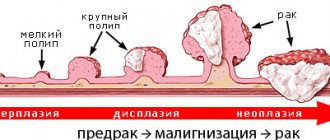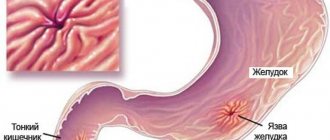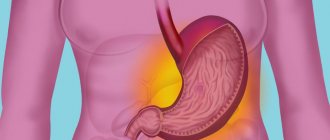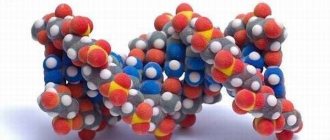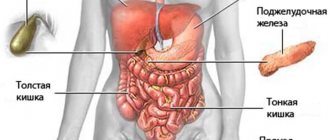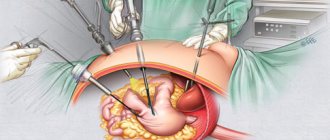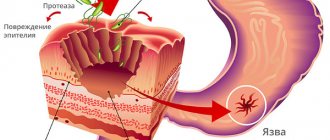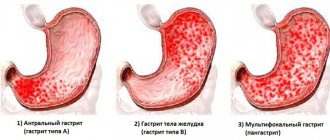The pyloric sphincter or pylorus is a muscular ring located in the lower (pyloric) part of the stomach. Its task is to delimit the digestive system in such a way that the food bolus (chyme) does not immediately fall into the duodenum, but remains directly in the stomach for some time. Normally, the pylorus is constantly in a compressed state, only periodically passing a portion of semi-digested food into the small intestine. Thanks to this mechanism, the delicate intestinal mucosa is protected from the aggressive effects of the acidic environment of the stomach; in addition, food has time to break down sufficiently and form chyme.
Gaping pylorus
Due to the influence of unfavorable factors, such as poor nutrition, the muscle ring ceases to close completely and pyloric insufficiency develops. The pathology is characterized by the appearance of unpleasant symptoms and disruption of the entire gastrointestinal tract. In the early stages of the disease, treatment is carried out with medication, but in advanced cases it is often necessary to resort to surgical intervention.
Why do the sphincter muscles weaken?
The main reason why the pylorus gapes is a weakening of the muscles of the pyloric part of the stomach.
- Most often, hypotension develops in old age due to weakening muscle tone throughout the body.
- This condition is also typical for pregnant women due to the influence of hormones.
- Sometimes the insufficiency (gaping) of the pylorus is a congenital pathology; in such cases, the defect can only be eliminated through surgery.
There are a number of unfavorable factors that can provoke the development of pyloric insufficiency:
- disruptions in nervous regulation;
- oncological formations of the digestive organs;
- improper diet;
- frequent overeating;
- inflammatory processes of the gastrointestinal tract (gastritis, duodenitis);
- sudden changes in hormonal levels.
In utero, pyloric gaping develops due to a genetic predisposition, as well as due to diseases suffered by the pregnant woman.
https://youtu.be/fwDD5CTwF6I
Description of the disease
Gastric atony is a serious disease that is accompanied by a gradual loss of muscle tone in this organ. Usually its development is preceded by asthenia or damage to the nerves of the gastrointestinal tract. The moment a person begins to consume food, the stomach relaxes.
When a bolus of food enters an organ, its walls contract. This function is otherwise called peristalsis. If it is suppressed for any reason, food stagnates in the system and is not digested. This phenomenon is accompanied by discomfort, and sometimes severe pain in the stomach appears.
The causes and treatment of pathology - these two issues still attract the attention of doctors from all over the world. It is known for sure that the development of the disease may be preceded by a previous operation. Medicine has also described cases where severe stress acted as a trigger.
There is no universal method for treating the disease. Therapy is selected individually. For some patients, a change in diet is enough, while others require long-term drug treatment. Let's look at these issues in more detail below.
How does pylorus deficiency manifest?
Symptoms of incomplete closure of the pylorus appear and increase gradually: the larger the defect in the sphincter, the brighter and more severe the clinical picture. The main signs of pathology include:
- pain in the abdomen, which is mainly localized in the pyloroduodenal zone (slightly to the right and below the solar plexus);
- the presence of plaque on the tongue, usually yellow;
- belching that leaves a bitter taste;
- a feeling of heaviness and discomfort in the epigastric region (the place of projection of the stomach is the solar plexus).
Pyloric insufficiency has similar symptoms to other pathologies of the gastrointestinal tract, but it can be distinguished from them by several features:
- antacids have a minor and short-lived effect on the patient;
- after eating, relief does not occur, and in some cases the patient’s condition may worsen;
- Eating food leads to nausea and vomiting.
At the first manifestations of the disease, you need to contact a specialist for help, since prolonged ignoring of the symptoms leads to the impossibility of treating the deficiency using a non-surgical method.
Preventive measures
To prevent the occurrence of pyloric insufficiency, you need to:
- maintain a diet;
- avoid smoking;
- stop drinking alcoholic beverages and soda;
- promptly diagnose and treat any gastrointestinal diseases, especially ulcers that are localized in the pyloric region, and inflammation (gastritis, duodenitis).
It is advisable to periodically visit a specialist and undergo preventive examinations and examinations. This will help to identify pathology at the very beginning of development and begin treatment on time.
It is worth noting that a healthy person produces an acidic environment in the stomach, and an alkaline environment in the esophagus. But various diseases disrupt this harmony, provoking the development of all kinds of pathologies. Often the function of the pylorus undergoes changes due to the reflux of stomach contents into the lumen of the sphincter. This violates its integrity. Other reasons can also provoke a malfunction of this muscle:
- eating disorder;
- imbalance in metabolic processes;
- problems with the regulatory system;
- prolonged fasting;
- oncology.
The result of these effects is a number of diseases.
Gastroenterologist Mikhail Vasilievich:
“It is known that for the treatment of the gastrointestinal tract (ulcers, gastritis, etc.) there are special drugs that are prescribed by doctors. But we will not talk about them, but about those medicines that you can use yourself and at home...” Read more >>>
DO YOU STILL THINK THAT IT IS HARD TO CURE YOUR STOMACH?
Judging by the fact that you are now reading these lines, victory in the fight against diseases of the gastrointestinal tract is not yet on your side.
Have you already thought about surgery? This is understandable, because the stomach is a very important organ, and its proper functioning is the key to health and well-being. Frequent abdominal pain, heartburn, bloating, belching, nausea, bowel dysfunction. All these symptoms are familiar to you firsthand.
But perhaps it would be more correct to treat not the effect, but the cause? We recommend reading the story of Galina Savina, how she cured her stomach. Read the article >>
Have you been struggling with GASTRITIS and ULCERS for many years without success?
“You will be amazed at how easy it is to cure gastritis and ulcers just by taking it every day.
The pylorus is a sphincter that separates the digestive organ from the duodenum. Its role is to regulate the amount of digested food coming from the stomach.
As a result of a violation of the diet, the appearance of malignant tumors, problems with the regulatory system and the influence of other reasons, the sphincter malfunctions. If the pylorus does not close, treatment is required.
Types of pathologies and their clinic
Pathologies of the pylorus look like this:
- polyps;
- spasms;
- sphincter insufficiency;
- pyloric stenosis.
A pyloric polyp is a benign neoplasm that blocks the passage. This phenomenon interferes with the normal functioning and activity of the muscle. If you ignore the disease, there is a risk of the tumor transforming into a cancerous growth.
Sphincter spasms occur due to overstrain of muscle fibers. This causes difficulty in the passage of gastric juice into the small intestine, as the opening narrows. A similar problem can be caused by gastritis, gastric ulcers and congenital diseases of the digestive tract. Often in this state, the sphincter becomes large and begins to stretch, which helps to relieve its functions. In this condition, the patient may experience the following symptoms:
- pain after eating;
- slight weight loss;
- bad breath;
- nausea;
- vomit;
- frequent urge to urinate;
- colorless urine.
Pyloric insufficiency is a disorder of motor activity in which the muscle does not close completely, which leads to accelerated emptying or release of duodenal contents. Characteristic symptoms for this pathology are:
- yellowish coating on the tongue;
- stomach ache;
- bitter taste;
- belching;
- vomiting with bile;
- discomfort inside the peritoneum.
Gastric pyloric stenosis is a serious disease that occurs due to chronic ulcers. Scarring of the healing tissue at the site of ulcerative lesions, which occurs over a long period of time, leads to gastric obstruction. This negatively affects digestion, causing some symptoms:
- burping;
- vomiting of undigested food particles;
- feeling of heaviness under the ribs;
- rumbling in the abdominal cavity;
- painful attacks.
When the pylorus of the stomach is diseased, symptoms of general malaise and dizziness are also observed. Taken together, such manifestations bring the patient a lot of unpleasant sensations.
Methods for diagnosing atony
Diagnosis begins with a thorough collection of complaints. It is also important to establish what concomitant pathologies, previous operations or injuries the patient has.
Upon palpation, an experienced doctor will detect expansion of the walls of the stomach. When percussing with a finger over its upper parts, tympanitis is often clearly audible, which is a sign of air accumulation.
After the examination, they are sent for laboratory tests. Particular attention is paid to the level of glucose, creatinine, urea, liver enzymes and bilirubin to exclude possible concomitant pathologies.
Gastroscopy is required - an endoscopic examination method in which the walls of the stomach are examined from the inside and acidity is measured. The patient is also sent for an ultrasound of the abdominal organs, where, in addition to the stomach, the liver, intestines, pancreas, aorta, and spleen are also examined. If necessary, it is also possible to perform computed tomography or magnetic resonance imaging.
If vascular problems are suspected, modern clinics have the opportunity to conduct angiography of the abdominal vessels, which allows a detailed study of the patency of the arteries.
Sometimes consultation with additional specialists is required - a neurologist, endocrinologist or vascular surgeon.
Treatment
Treatment of pyloric pathologies is carried out comprehensively:
- the underlying disease is treated with prokinetics - drugs that increase tone;
- antacids that help block heartburn;
- enzymes for the proper functioning of hydrochloric acid;
- painkillers and anti-inflammatory medications.
If a patient is diagnosed with pyloric stenosis, he is prescribed drugs that stimulate the healing of the ulcer, as well as drugs to suppress the secretion of gastric acid. During treatment in a hospital, the secretions and contents of the organ are regularly suctioned from the patient's stomach.
After three days, the patient is allowed to drink water, then the condition of the pylorus is examined. If there is a wide muscle opening, the patient is allowed to eat, but in limited quantities. Severe pathology is treated through surgery. Before the operation, antiulcer therapy is prescribed, the general condition of the patient and the electrolyte composition of his blood are normalized.
Approximate price tags for treatment in major centers
| X-ray of the stomach | Average cost of the procedure |
| Moscow | 2000 rub. |
| St. Petersburg | 1700 rub. |
| Ekaterinburg | 1050 rub. |
| Kyiv | 900 UAH |
| Dnepropetrovsk | 760 UAH |
| Minsk | 60 bel. rub |
| Almaty | 6000 tenge |
| Omsk | 717 rub. |
| Novosibirsk | 1033 rub. |
| Kharkiv | 780 UAH |
| Nizhny Novgorod | 1000 rub. |
| Samara | 1540 rub. |
| Chelyabinsk | 1005 rub. |
| Odessa | 865 UAH |
| Volgograd | 870 rub. |
| Permian | 800 rub. |
Tips and tricks
The patient is recommended to take actions to reduce intragastric pressure. It is also necessary to fight excess weight and follow a strict diet. Food should be consumed in a semi-liquid state, in small portions. Food should be at a comfortable temperature for consumption.
The pylorus of the stomach is located at the point of its transition to the small intestine. Formed from pronounced muscle fibers that are responsible for closing and opening the valve. When there is a spasm or blockage of the hole, food stagnates and rotting processes develop in the stomach. In case of insufficient closure, there is a constant gaping and free passage of food along with hydrochloric acid, which can lead to duodenal ulcer. Treatment of pathology consists of performing surgery.
Prevention
In order to prevent the development of pylorus pathologies, it is recommended to follow the following recommendations:
- timely diagnosis and treatment of ulcers of various locations;
- rejection of bad habits;
- balanced diet;
- preventing evasion from periodic examinations;
- avoiding wearing tight clothing.
A person who strives to fulfill all instructions and understands the danger of neglect of the disease can quickly recover from these pathologies.
Anatomy and structure
The pylorus is a dense cushion or protrusion that is located at the junction of the stomach and duodenum. Its muscle layer forms a constriction that prevents food from entering the small intestine prematurely. It consists of oblique, circular and longitudinal muscles, which are covered with mucous membrane. The pylorus is also involved in preventing the backflow of food masses from the intestines into the stomach. This is ensured not only by contraction of muscle fibers, but also by swelling of the mucous membrane in the area of the cushion.
When food stagnates, an ulcer of the pyloric part of the stomach develops.
Prevention
To prevent the development of diseases of the digestive system, it is necessary to follow simple preventive measures.
How to avoid problems with the pylorus:
- eat healthy and regularly;
- maintain a daily routine;
- give up addictions;
- wear comfortable, loose clothing;
- do not starve, avoid strict diets.
To avoid stomach problems, you need to get rid of bad habits
Periodic examination and diagnosis will help prevent the development of complications and avoid surgical intervention.
When the functions of the pylorus are impaired, various pathologies of the digestive system develop; the diseases have different causes of origin, differ in symptoms and treatment methods. But prevention and diet are the same for all sphincter diseases.
Rate the article ( 8 ratings, average 4.88 out of 5)
Important! A remedy for heartburn, gastritis and ulcers, which has helped a huge number of our readers. Read more >>>
The pylorus of the stomach is usually called a small narrowing of the digestive organ that passes into the duodenum. The second name of the anatomical structure is pylorus, which reflects its Latin name. The pylorus of the stomach is equipped with thickened smooth muscle walls, corresponding to a length of 1-2 cm. Two curvatures are noticeable throughout the gastric region: the smaller one is recognized by its convexity, and the larger one by the visual deepening of the surface.
Next to the pylorus, the bulbar section of the duodenum, also called the bulb, borders on one side, and the vestibule of the pylorus - the antrum (pyloric) section on the other. Some anatomists call the pylorus the pyloric canal, and the pylorus is allocated to the third part of the digestive organ, most distant from the esophagus.
The pylorus of the stomach is least prone to displacement when trying to pull the organ by the ligament of the stomach and colon, as well as by the greater omentum. The reason for the small displacement of the pylorus is explained by the fixation of the ligaments from the liver to the duodenum and the gastrohepatic ligament. In addition, the pylorus is securely fixed by the duodenal bulb of the digestive tract.
The curvature of the pylorus changes, which becomes noticeable during fluoroscopic examination with the introduction of a contrast agent. An overfilled stomach with signs of atony enhances the contours of the bulge and groove, giving the pylorus a hook-like shape. When fluoroscopy of an empty stomach, the contours of the depression and bulge have flat edges and an unclear border.
Closer to the border of the pylorus with the duodenal bulb, a vein runs transversely relative to the peritoneum.
Palpation of the pylorus shows its unequal sizes in different conditions. During good general tone of the stomach, the thickness of the pylorus is compared to a human finger. The atonic state of the digestive organ noticeably reduces the tension of the annular muscles; the diameter of the pylorus is palpated at about 1 cm, and with severe severe atony - less than 1 cm.
The circular muscles of the pylorus have the thickest layer at the border with the bulbar part of the duodenum. The pattern of thickening of the muscle layer can be traced throughout the entire vestibule of the stomach and its pylorus. On the contrary, the intestinal bulb has the thinnest layer of smooth muscle fibers, located in two directions: annular and transverse.
The mucous membrane of the pylorus has varying degrees of displacement relative to the submucosa and muscular layer. Closer to the antrum of the stomach, the mucous membrane moves slightly; in the opposite direction, its displacement is more pronounced and reaches a maximum in the sphincter region, turning into a bicuspid valve. When the mucous membranes close, the liquefied food mass rushes into the duodenum through the stellate fissure. In a normal state, the lumen of the stellate fissure of the mucous valves regulates the forward flow of food; in the opposite direction, the flow of liquid mass is difficult due to the tight slamming of the valves. With pathologies of the pylorus that increase the lumen of the gap, the food mass rushes in the duodenogastric direction.
The degree of tension of the pylorus depends on the filling of the blood vessels with blood, which determines the process of swelling of the mucosa and submucosa.
Gatekeeper functions
The lower gastric sphincter, with the help of many muscle fibers, forms a specific closing apparatus. It prevents the premature reflux of food into the intestines and makes it possible to sufficiently digest the food eaten. The functional significance of the pylorus also lies in preventing the reverse reflux of food after it enters the duodenum. Fatty foods stay in the stomach the longest, and liquid foods and carbohydrates last the longest. Thanks to the coordinated action of gastric and intestinal peristalsis, the sphincter closes immediately after a digested bolus of food passes through it. The mechanism of this action is associated with irritation of the mucous membrane by excess hydrochloric acid. First, the pylorus is affected, and then the duodenal bulb.
How does it work?
Relaxation and contraction of the muscles that form the pyloric sphincter is ensured by the flow of hydrochloric acid into the pyloric part of the stomach. Here it irritates special receptors that send impulses to the central nervous system. As a result, the excitation impulse is transmitted to the muscle layer and it relaxes, expanding the pyloric opening. The same sensitive receptors are located in the duodenal bulb. When a large amount of hydrochloric acid gets into this zone along with chyme, the muscles close and the hole closes.
Forms
There are 2 forms of pylorospasm:
Based on the nature of development, there are 2 types of pathology:
- primary – pylorospasm occurs as an independent pathology, is often congenital, and is diagnosed at an early age;
- secondary – develops against the background of other gastroenterological diseases or lesions of the nervous system, more common in adults.
Treatment of the compensated form of pylorospasm is often successful, complete recovery and improvement of the functioning of the pylorus and stomach are possible.
Pyloric diseases
The following pathological conditions of the gastric sphincter are distinguished:
- septal hernia;
- atony or gaping pylorus;
- Helicobacter pylori infection;
- insufficiency of the pylorus of the stomach, as a result of which the valve does not close;
- sphincter erosion;
- valve spasm;
- polypomatosis;
- stomach ulcer in this section.
Return to contents
This pathology is excessive compression of the muscles in the area of the hole. In this case, the patient’s patency through the digestive tube is impaired. The patient feels heaviness in the stomach, a feeling of fullness and bad breath, belching of rotten contents, and in severe cases, nausea and vomiting. Over time, the condition improves significantly, and food begins to flow into the intestines.
A spasm of the pylorus of the stomach can be provoked by the following factors on the human body:
- peptic ulcer with a defect in this area;
- multiple polyps;
- deficiency of vitamins and minerals;
- congenital disorder of gastric innervation;
- inflammation of the organ mucosa;
- exposure to nicotine;
- hormonal imbalance.
Return to contents
The development of pathology is associated with burdened heredity or constant exposure to various irritating factors. In this case, the patient’s evacuation of contents from the stomach is impaired, since the neoplasm can completely block the food outlet. For such patients, surgical intervention to remove growths is recommended.
If there is complete closure of the pyloric opening without periodic resumption of food passage, then the patient is diagnosed with stenosis or blockage. This pathology is a congenital structural anomaly or can be caused by an ulcer of the antrum of the stomach. In addition, stenosis is one of the signs of a new growth. The pathology causes pain in the epigastrium, belching of rotten contents, bad breath, nausea, vomiting and a white coating of the tongue. Over a long period of time, the patient may develop symptoms of starvation, dehydration and multivitamin deficiency.
It manifests itself in the form of inactive closure of the hole due to a violation of the structure of muscle fibers or innervation. In this case, the lower gastric opening gapes, allowing undigested food into the intestines along with chemically active hydrochloric acid. Therefore, this disease provokes inflammation of the mucous membrane of the duodenum with the formation of ulcers and erosions on it.
It is a defect in the gastric wall. Causes significant pain, nausea, vomiting and can sometimes cause massive bleeding. In this case, the organ can no longer carry out the digestive process normally due to the constant negative impact on the area where the ulcer is located. A long-term ulcer of the pylorus of the stomach causes scarring and narrowing of the tissues that form the opening. In this regard, the process of evacuation of food from the stomach is disrupted.
Treatment of pyloric pathologies
If the sphincter has closed as a result of muscle spasm, then it is possible to use medications, antispasmodics, which will relax the smooth muscles of the stomach and intestines. In addition, such patients require a special gentle diet with divided meals in small portions. If the measures taken are ineffective or in the case of acute gastric obstruction caused by a polyp or pyloric stenosis, surgery is performed. The intervention is aimed at mechanically restoring the movement of food and normalizing its digestion.
If the patient exhibits atony or symptoms of sphincter insufficiency, then the use of antacids that can neutralize the harmful effects of hydrochloric acid is indicated as conservative measures. Otherwise, an ulcer of the pyloric canal develops, which does not heal for a long time and causes frequent bleeding. Surgical intervention consists of suturing the defect or creating an artificial stoma. Traditional methods of treatment are used in combination with the main therapy.
Use of folk remedies
Medical experts oppose the use of folk remedies as primary therapy. However, they can be used for additional treatment. But first you need to consult with your doctor so that he approves this or that traditional medicine recipe, taking into account the individual characteristics of the patient’s body and focusing on the results of diagnostic studies.
If the pylorus of the stomach does not close, you can use the following traditional medicine recipes:
- mix the herb St. John's wort, motherwort and valerian in equal proportions, then brew 1 tablespoon of the mixture in a glass of boiling water, the infusion is kept until completely cool, then filtered and used internally with honey;
- Squeeze the juice from fresh plantain leaves and take 1 teaspoon orally before meals during exacerbations of the disease;
- Juice is squeezed out of dandelion flowers and taken orally before meals.
In addition, in case of insufficiency of the pylorus of the stomach, decoctions of calamus root, caraway-based tincture and other medicinal drugs are taken.
